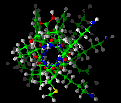 Molecular
System Database - Systems with Symmetry and Periodicity
Molecular
System Database - Systems with Symmetry and Periodicity Molecular
System Database - Systems with Symmetry and Periodicity
Molecular
System Database - Systems with Symmetry and Periodicity
SymmetryObjectwhere NAME specifies the symmetry group. Thus the statement
SymmetryOperator
MainCell/NAME/AsymmetricBond
@group (PNA21) [ORIGIN_1]in an .mdf file gives rise to a table named:
MainCell/PNA21/ORIGIN_1/AsymmetricBondThe following tables acquire additional columns for molecular systems involving symmetry and periodicity:
Cell
Atom
Cell (type rid) GroupLabel (type string) GroupQualifier (type string) NumberSymmetryMatrices (type short) Change (type short) DegreesFreedom (type unsigned) AsymmetricAtomColumn (type string) SymmetryMatrixColumn (type string) AsymmetricBondTable (type string)A row of the SymmetryObject table represents an instance of a symmetry group (point, plane, or space, depending upon whether the system is nonperiodic, 2D-periodic, or 3D-periodic).
The entry in the Cell column specifies the associated cell. It is a reference to the Cell table.
The entry in the GroupLabel column is a group label such as PNA21.
The entry in the GroupQualifier column is a group qualifier such as ORIGIN_1.
The NumberSymmetryMatrices column contains the number of symmetry operators (i.e., rows in the SymmetryOperator table) in the symmetry group.
The entry in the Change column is a flag indicating that the positions of asymmetric atoms (base atoms specified explicitly) have changed (as in a minimization step) and that the positions of the full atom set (atoms specified through application of symmetry operators to asymmetric atoms) must therefore be regenerated.
The DegreesFreedom column contains the number of degrees of freedom of the associated molecular system, diminished by symmetry constraints.
Currently, AsymmetricAtomColumn always contains the string "AsymmetricAtom". This is the name of the extra column in the Atom table that identifies the asymmetric atom associated with a given atom.
Currently, SymmetryMatrixColumn always contains the string "SymmetryMatrix".
AsymmetricBondTable contains "MainCell/NAME/AsymmetricBond" (e.g., "MainCell/PNA21/ORIGIN_1/AsymmetricBond").
SymmetryObject (type rid) Matrix (type float(16)) XYZ (type string)A row of the SymmetryOperator table corresponds to a particular symmetry operator.
The SymmetryObject column specifies the associated symmetry object. It is a reference to the SymmetryObject table.
The Matrix column contains the 4-by-4 matrix representing the symmetry operator.
The XYZ column contains the symmetry operator descriptor (e.g., "-x,-y,z+1/2").
Atom-1 (type rid) Atom-2 (type rid) Order (type float) Bibond (type rid) XYZLatticeOffset (type short(periodicity)) SymmetryMatrix (type short)The first five columns are analogous to the columns of the same name in the P1Bond table.
The MainCell/NAME/AsymmetricBond table includes an additional column (SymmetryMatrix) to hold the symmetry operator identifier. This operator and then the lattice offset XYZLatticeOffset are applied to Atom-2, in order to produce the bondmate of Atom-1. In this table, both Atom-1 and Atom-2 are asymmetric atoms. The asymmetric bond table can hold asymmetric atom identifiers plus symmetry and lattice offsets--this information corresponds to the connectivity data in the .mdf file for full-symmetry systems.
AsymmetricAtom (type rid) SymmetryMatrix (type short) ProjectionMatrix (type double(9)) DegreesFreedom (type short)Entries in the AsymmetricAtom column are null for asymmetric atoms, and, if not null, indicate the asymmetric atom from which the given atom is derived.
An entry in the SymmetryMatrix column is the number of the symmetry operation used to produce the given atom from the associated asymmetric atom.
An entry in the ProjectionMatrix column is the transformation used to maintain symmetry in the course of dynamics, which would break symmetry if left to itself.
An entry in the DegreesFreedom column represents the degrees of freedom associated with the given atom. In general, there are 3 degrees of freedom. However, when an atom is confined by symmetry to a plane, line or point, this number is reduced accordingly (to 2, 1, or 0).
 Main
access page
Main
access page  Advanced-Use access.
Advanced-Use access.
 BTCL Databases access
BTCL Databases access
 Molecular System Database
Molecular System Database
Copyright Biosym/MSI